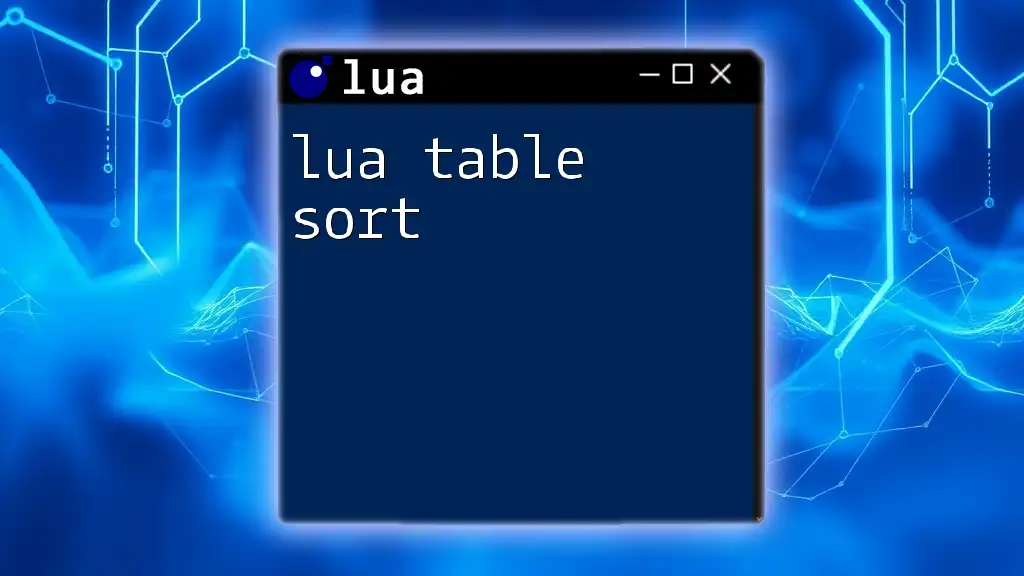The Lua garbage collector automatically reclaims memory occupied by objects that are no longer accessible in the program, helping to optimize resource management.
Here’s a code snippet demonstrating how to manually invoke the garbage collector in Lua:
-- Manually trigger garbage collection
collectgarbage()
-- Print the amount of memory used by Lua in kilobytes
print("Memory used: " .. collectgarbage("count") .. " KB")
Overview of Garbage Collection in Lua
What is Garbage Collection?
Garbage collection (GC) is a form of automatic memory management that is essential in programming languages like Lua. It reclaims memory occupied by objects that are no longer in use, effectively preventing memory leaks. By automatically handling this aspect of memory management, the lua garbage collector helps developers focus on building features rather than worrying about memory allocation and deallocation.
Importance of Garbage Collection
The significance of efficient garbage collection cannot be overstated. It ensures memory efficiency, thus optimizing the overall memory usage of your Lua applications. Additionally, it enhances performance by minimizing the manual overhead that developers would typically incur when managing memory.

How Lua's Garbage Collector Works
Mechanism of Garbage Collection
Lua primarily employs a tracing garbage collector, which actively keeps track of objects in memory to determine which are still reachable and which can be reclaimed. The first step in the garbage collection process is to identify and mark all objects that are in use. Once it has marked these objects, the garbage collector can then proceed to "sweep" the unused objects from memory, thereby reclaiming space.
Phases of Garbage Collection
The garbage collection process consists of two crucial phases:
- Mark Phase: This phase identifies which objects are in use by tracing references from the root objects.
- Sweep Phase: Once the mark phase is complete, the sweep phase removes all objects that remain unmarked, reclaiming their memory space.
Understanding Lua's Collection Methods
Generational vs. Non-Generational
Interestingly, Lua adopts a generational garbage collection strategy. This approach allows the collector to work more efficiently by focusing on younger objects, which are often the ones that become unreachable more quickly than older objects.
Default Collection Modes
Lua comes with a default mode for garbage collection that operates automatically based on the allocation and deallocation of memory. However, for advanced users and those with specific needs, Lua also allows for manual control over the garbage collector through various functions.

Configuring the Garbage Collector
Using `collectgarbage` Function
Lua's `collectgarbage` function serves as a control mechanism for garbage collection. This function offers several options, including:
- collect: Invokes a full garbage collection cycle, allowing for immediate cleanup.
- stop: Temporarily halts the garbage collector to enhance performance during critical operations.
- restart: Resumes garbage collection if it was previously halted.
Example Code Snippet: Setting Up GC Control
-- Stopping the garbage collector
collectgarbage("stop")
-- Performing manual garbage collection
collectgarbage("collect")
Adjusting Garbage Collection Performance
Tuning GC Parameters
Fine-tuning the garbage collection process can significantly impact performance. You can adjust the thresholds that trigger garbage collection by setting the pause and step multiplier. Understanding how these parameters work allows developers to optimize their applications effectively.
Example Code Snippet: Adjusting Parameters
-- Adjust the pause and step multiplier
collectgarbage("setpause", 200) -- default is 200
collectgarbage("setstepmul", 200) -- default is 200

Common Issues and Best Practices
Memory Leaks Explained
In Lua, a memory leak may occur when the developer unintentionally keeps references to objects that are no longer needed, thereby preventing them from being collected by the lua garbage collector. This situation can lead to unnecessary memory consumption and may slow down your application over time.
Identification of Memory Leaks
Detecting memory leaks can often be performed using memory profiling tools that help identify these issues. One method of avoiding memory leaks is to ensure that any reference to an object is explicitly terminated when it is no longer required.
Example Code Snippet: Terminating a Reference
local obj = { data = "example" }
-- Do something with obj
obj = nil -- Explicitly releasing the reference
Best Practices
To effectively manage garbage collection in Lua, it's essential to follow a few best practices:
- Avoid Circular References: Circular references can complicate the garbage collection process. Ensure that objects do not reference each other unnecessarily, as this can lead to memory leaks.
- Use Metatables Wisely: Careful design of metatables can limit unintended references, making the garbage collection process more efficient.

Advanced Garbage Collection Techniques
Weak Tables
One of the advanced features provided by Lua is the use of weak tables. Weak tables allow you to maintain references to objects without preventing them from being collected by the garbage collector. This is especially useful when you want to store caches or metadata but do not want those objects to remain in memory indefinitely.
Example of Weak Tables
-- Creating a weak table for object references
local weakTable = {}
setmetatable(weakTable, { __mode = "v" }) -- Weak references to values
weakTable[some_key] = some_value

Conclusion
Understanding and effectively managing Lua's garbage collector is crucial for optimizing memory usage in your applications. By leveraging Lua's automatic garbage collection features, developers can enhance the efficiency of their code while reducing the complexity associated with manual memory management.
Final Tips
Continuously monitoring your application’s performance can help in fine-tuning garbage collection settings for optimal efficiency. Furthermore, utilizing weak tables and following best practices can further enhance your application's performance and memory management capabilities.
With these insights into the lua garbage collector, you’re well-equipped to harness its capabilities in your Lua programming endeavors.

















